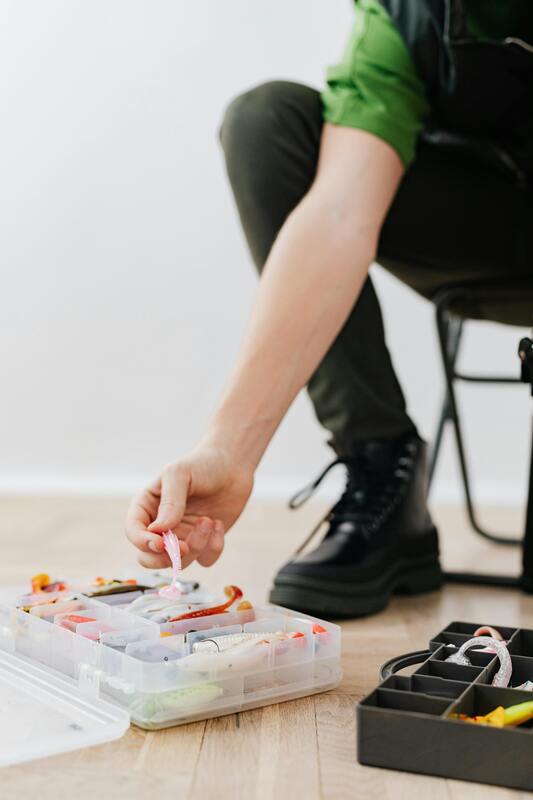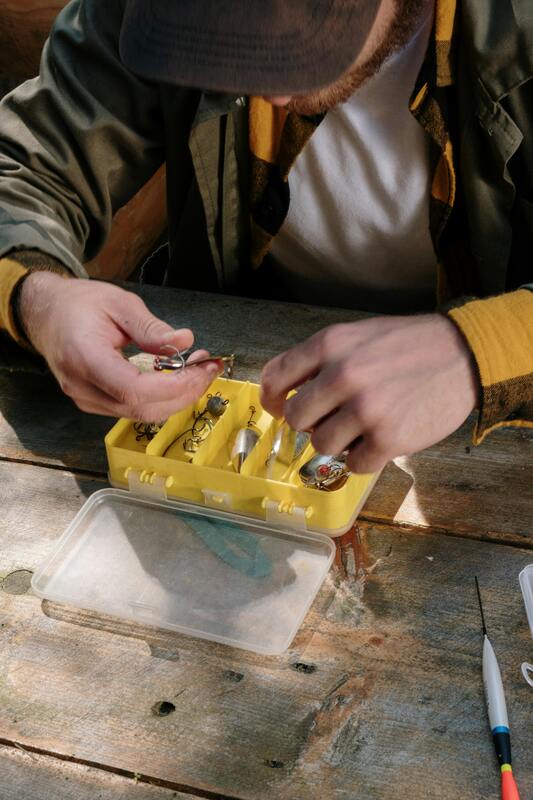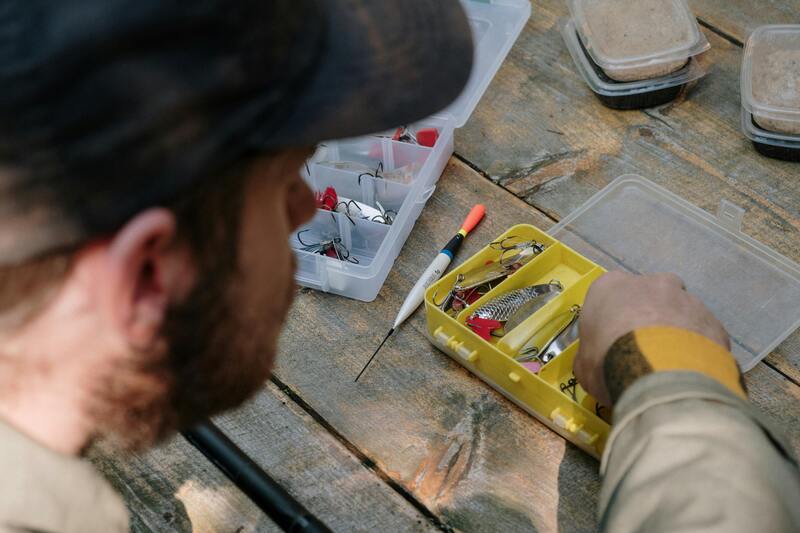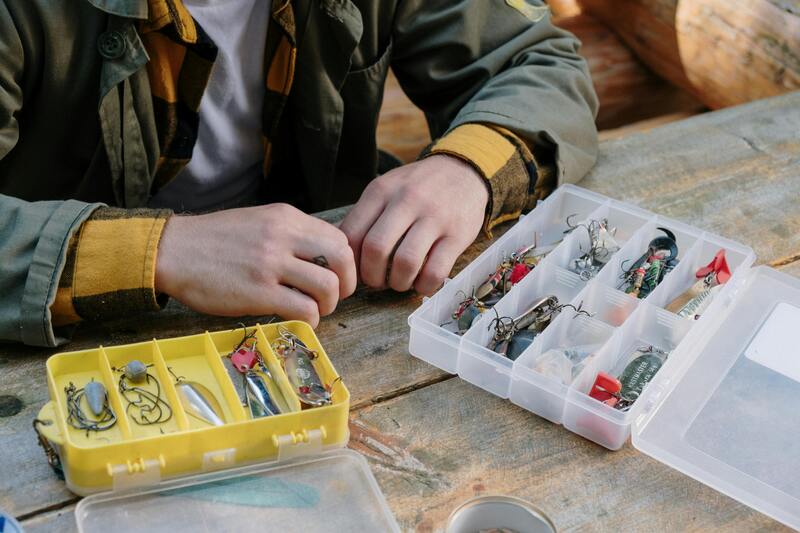Okay, here's a more natural take on that fishing kit info:
1. What's a Fishing Kit?
Think of a fishing kit as your all-in-one tackle box. It's got the stuff you need to catch fish – rod, reel, hooks, line, the works. They're made for everyone from newbies to experienced anglers. Having everything together makes fishing way easier and more fun.
2. Different Kinds of Fishing Kits
Usually, kits are grouped by where you're fishing:
* Freshwater Kit: For rivers, lakes, ponds. It’s for smaller fish like bass or trout.
* Saltwater Kit: Made for the ocean. The gear can handle saltwater without rusting, good for bigger fish.
* Fly Fishing Kit: This is special. It has a lightweight rod, reel, and fake flies to trick the fish.
* Ice Fishing Kit: Short rods and gear that can handle the cold.
* Surf Fishing Kit: Long rods and tough lines to cast far from the beach.
3. What's Usually Inside
A decent fishing kit should have:
* Rods: Your main tool to cast the bait & reel in the fish. Get spinning, baitcasting, or fly rods made from fiberglass, carbon fiber, or a mix. River rods are short (5-7 ft), surf rods are long (10-14 ft).
* Reels: This sits on the rod and holds the line. It can be spinning, baitcasting, or fly reel. Match it to the rod & what you're fishing for.
* Fishing Lines: Connects your rod to the hooks. Use monofilament (good all-around), fluorocarbon (hard to see underwater), or braided (strong). Pick the right strength based on the kind of fish.
* Hooks: Metal bits that hold bait and catch fish. Small hooks are for small fish, big hooks for big fish. They come in shapes like J-hooks or circle hooks.
* Baits & Lures: Things to get the fish to bite. You can use real worms or fake stuff like spinners and jigs. Match the bait to the fish and water.
* Floats & Sinkers: Floats keep the bait at a depth and show when you get a bite. Sinkers help you cast farther and sink the bait.
* Other Stuff:
* Tackle Box: For organizing your hooks and lures.
* Fishing Pliers: To cut lines, get hooks out.
* Knife: To clean fish or cut bait.
* Fishing Net: To help you land your catch.
* Line Clippers: To trim line.
* Hook Removers: To get hooks out easy.
4. Things You Might Want
* Fishing gloves
* A place to keep fish like a stringer or cooler
* A rod holder so your rod doesn't fall
* First aid kit
* Waterproof bag
5. How to Pick a Kit
Think about:
* Where you'll fish: rivers, ocean, ice?
* What you want to catch: small or big fish?
* Your skill level: Simple kits for beginners, fancier stuff for experts.
* If you'll be carrying it a lot: Get a small one if you're hiking.
6. Taking Care of Your Kit
* Rinse saltwater gear after you use it.
* Dry everything before you put it away.
* Oil your reel once in a while.
* Keep hooks from rusting by organizing them.
* Replace lines now and then so they don't break.
7. Why Get a Fishing Kit?
* Everything's in one spot.
* Saves time since you won't forget stuff.
* Makes fishing easier & you'll catch more!
1. What's a Fishing Kit?
Think of a fishing kit as your all-in-one tackle box. It's got the stuff you need to catch fish – rod, reel, hooks, line, the works. They're made for everyone from newbies to experienced anglers. Having everything together makes fishing way easier and more fun.
2. Different Kinds of Fishing Kits
Usually, kits are grouped by where you're fishing:
* Freshwater Kit: For rivers, lakes, ponds. It’s for smaller fish like bass or trout.
* Saltwater Kit: Made for the ocean. The gear can handle saltwater without rusting, good for bigger fish.
* Fly Fishing Kit: This is special. It has a lightweight rod, reel, and fake flies to trick the fish.
* Ice Fishing Kit: Short rods and gear that can handle the cold.
* Surf Fishing Kit: Long rods and tough lines to cast far from the beach.
3. What's Usually Inside
A decent fishing kit should have:
* Rods: Your main tool to cast the bait & reel in the fish. Get spinning, baitcasting, or fly rods made from fiberglass, carbon fiber, or a mix. River rods are short (5-7 ft), surf rods are long (10-14 ft).
* Reels: This sits on the rod and holds the line. It can be spinning, baitcasting, or fly reel. Match it to the rod & what you're fishing for.
* Fishing Lines: Connects your rod to the hooks. Use monofilament (good all-around), fluorocarbon (hard to see underwater), or braided (strong). Pick the right strength based on the kind of fish.
* Hooks: Metal bits that hold bait and catch fish. Small hooks are for small fish, big hooks for big fish. They come in shapes like J-hooks or circle hooks.
* Baits & Lures: Things to get the fish to bite. You can use real worms or fake stuff like spinners and jigs. Match the bait to the fish and water.
* Floats & Sinkers: Floats keep the bait at a depth and show when you get a bite. Sinkers help you cast farther and sink the bait.
* Other Stuff:
* Tackle Box: For organizing your hooks and lures.
* Fishing Pliers: To cut lines, get hooks out.
* Knife: To clean fish or cut bait.
* Fishing Net: To help you land your catch.
* Line Clippers: To trim line.
* Hook Removers: To get hooks out easy.
4. Things You Might Want
* Fishing gloves
* A place to keep fish like a stringer or cooler
* A rod holder so your rod doesn't fall
* First aid kit
* Waterproof bag
5. How to Pick a Kit
Think about:
* Where you'll fish: rivers, ocean, ice?
* What you want to catch: small or big fish?
* Your skill level: Simple kits for beginners, fancier stuff for experts.
* If you'll be carrying it a lot: Get a small one if you're hiking.
6. Taking Care of Your Kit
* Rinse saltwater gear after you use it.
* Dry everything before you put it away.
* Oil your reel once in a while.
* Keep hooks from rusting by organizing them.
* Replace lines now and then so they don't break.
7. Why Get a Fishing Kit?
* Everything's in one spot.
* Saves time since you won't forget stuff.
* Makes fishing easier & you'll catch more!
8. Cool Fishing Kit Extras
Beyond the basics like rods, reels, and hooks, a great fishing kit can have:
A. Little Things That Make a Big Difference
Swivels: These stop your line from getting all twisted up.
Snaps: Change lures fast without having to retie everything.
Beads: They guard your knots and can flash to grab a fish's attention.
Leader Lines: A tougher line you hook to your main line to fight sharp teeth or rough stuff.
B. Special Hooks and Setups
Treble Hooks: Hooks with three points on them so you can wrangle bigger fish.
Circle Hooks: These are better for letting fish go because they hurt them less.
Drop Shot Rigs: They let your bait hang above the lake/river bottom, which is sweet for picky fish.
Carolina & Texas Rigs: Special ways to set up fake worms and stuff when you're fishing in lakes and rivers.
C. Stuff for Throwing and Pulling
Casting Weights: Help you throw your lure way out there.
Trolling Weights: Keep your bait down at the same depth when you're moving a boat.
Downriggers: Control how deep your lure goes when you're pulling it behind a boat in deep water.
9. Survival/Emergency Fishing Kits
Some people who fish bring kits made for the wild, like:
Rods That Fold Up: Rods you can squish down or pull in.
Tiny Reels and Lines: For saving space.
Tools That Do It All: A knife, pliers, and hook remover all in one thing.
Bait Traps: Easy traps for getting little fish if you really need them.
Storage That Can Take a Beating: Keeps your stuff dry when you're out in bad weather.
10. Getting Your Kit in Order
The better you organize, the easier it is to fish:
How to Set Up Your Tackle Box
Little spots for hooks, weights, and fake bait.
Keep live bait away from the fake stuff.
Putting Away Your Rods & Reels
Keep rods safe in a tube or case.
Clean and grease your reels before you put them away.
Where to Keep Your Extras
Use little bags for pliers, scissors, line clippers, and extra line.
Easy to Carry
Backpacks or bags with lots of spots are great.
If your kit is heavy, think about getting a tackle box on wheels.
11. What You Need for Different Kinds of Fishing
Fishing Type What Else You'll Need
Fly Fishing Fake flies, fly line, leader, waders, net
Ice Fishing Ice drill, short rod, tip-ups, ice scoop, warm gloves
Surf Fishing Long rods, sand spikes, heavy weights, umbrella
Saltwater Boat Fishing Reels that don't rust, strong line, pliers, gaff (big hook), cooler
Backpack Fishing Rods that shrink, light reel, small tackle box, multi-tool
12. Taking Care of Your Gear
Wash and Check: After you fish, wash your rods, reels, and lures. Look for rust or breaks.
Line Stuff: Get rid of old line, untangle it. Replace it if it's worn.
Putting Stuff Away: Dry everything before you put it in a cool, dry place.
Hook Smart: Keep hooks covered so you don't poke yourself.
First Aid: Keep band-aids, wipes, and bug spray in your kit.
13. Stuff People Forget
Fish Scale: To see how big your catch is.
Measuring Tape: To make sure you're following the rules.
Chum Bucket: To get fish to come closer.
Waterproof Notebook: Write down what you caught, where, and what bait you used.
Camera Holder: Take pics of your fishing trips.
Extra Line: To rewind fast if you snap a line.
Headlamp: Need one for night fishing.
14. Getting the Most from Your Fishing Kit
Make It Your Own: Have different lures for the kinds of fish you want.
Switch It Up: Change what bait and lures you're using.
Know the Rules: Make sure your hooks, sizes, and what you're catching are legal.
Practice Your Knots: Good knots mean you don't lose fish.
Change with the Seasons: Use different bait, lures, and lines for different weather.
Beyond the basics like rods, reels, and hooks, a great fishing kit can have:
A. Little Things That Make a Big Difference
Swivels: These stop your line from getting all twisted up.
Snaps: Change lures fast without having to retie everything.
Beads: They guard your knots and can flash to grab a fish's attention.
Leader Lines: A tougher line you hook to your main line to fight sharp teeth or rough stuff.
B. Special Hooks and Setups
Treble Hooks: Hooks with three points on them so you can wrangle bigger fish.
Circle Hooks: These are better for letting fish go because they hurt them less.
Drop Shot Rigs: They let your bait hang above the lake/river bottom, which is sweet for picky fish.
Carolina & Texas Rigs: Special ways to set up fake worms and stuff when you're fishing in lakes and rivers.
C. Stuff for Throwing and Pulling
Casting Weights: Help you throw your lure way out there.
Trolling Weights: Keep your bait down at the same depth when you're moving a boat.
Downriggers: Control how deep your lure goes when you're pulling it behind a boat in deep water.
9. Survival/Emergency Fishing Kits
Some people who fish bring kits made for the wild, like:
Rods That Fold Up: Rods you can squish down or pull in.
Tiny Reels and Lines: For saving space.
Tools That Do It All: A knife, pliers, and hook remover all in one thing.
Bait Traps: Easy traps for getting little fish if you really need them.
Storage That Can Take a Beating: Keeps your stuff dry when you're out in bad weather.
10. Getting Your Kit in Order
The better you organize, the easier it is to fish:
How to Set Up Your Tackle Box
Little spots for hooks, weights, and fake bait.
Keep live bait away from the fake stuff.
Putting Away Your Rods & Reels
Keep rods safe in a tube or case.
Clean and grease your reels before you put them away.
Where to Keep Your Extras
Use little bags for pliers, scissors, line clippers, and extra line.
Easy to Carry
Backpacks or bags with lots of spots are great.
If your kit is heavy, think about getting a tackle box on wheels.
11. What You Need for Different Kinds of Fishing
Fishing Type What Else You'll Need
Fly Fishing Fake flies, fly line, leader, waders, net
Ice Fishing Ice drill, short rod, tip-ups, ice scoop, warm gloves
Surf Fishing Long rods, sand spikes, heavy weights, umbrella
Saltwater Boat Fishing Reels that don't rust, strong line, pliers, gaff (big hook), cooler
Backpack Fishing Rods that shrink, light reel, small tackle box, multi-tool
12. Taking Care of Your Gear
Wash and Check: After you fish, wash your rods, reels, and lures. Look for rust or breaks.
Line Stuff: Get rid of old line, untangle it. Replace it if it's worn.
Putting Stuff Away: Dry everything before you put it in a cool, dry place.
Hook Smart: Keep hooks covered so you don't poke yourself.
First Aid: Keep band-aids, wipes, and bug spray in your kit.
13. Stuff People Forget
Fish Scale: To see how big your catch is.
Measuring Tape: To make sure you're following the rules.
Chum Bucket: To get fish to come closer.
Waterproof Notebook: Write down what you caught, where, and what bait you used.
Camera Holder: Take pics of your fishing trips.
Extra Line: To rewind fast if you snap a line.
Headlamp: Need one for night fishing.
14. Getting the Most from Your Fishing Kit
Make It Your Own: Have different lures for the kinds of fish you want.
Switch It Up: Change what bait and lures you're using.
Know the Rules: Make sure your hooks, sizes, and what you're catching are legal.
Practice Your Knots: Good knots mean you don't lose fish.
Change with the Seasons: Use different bait, lures, and lines for different weather.



